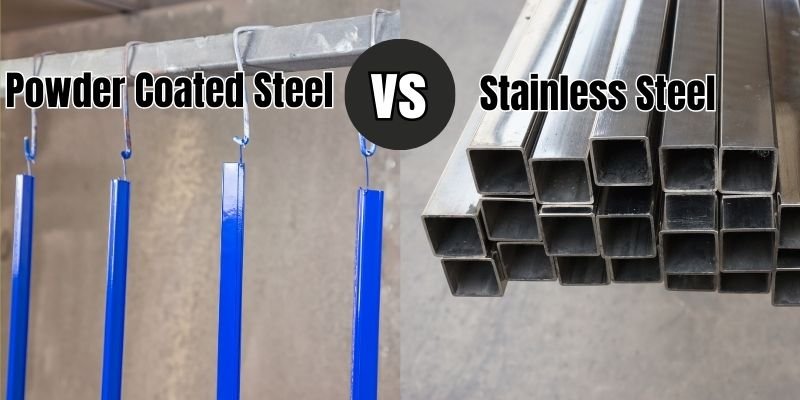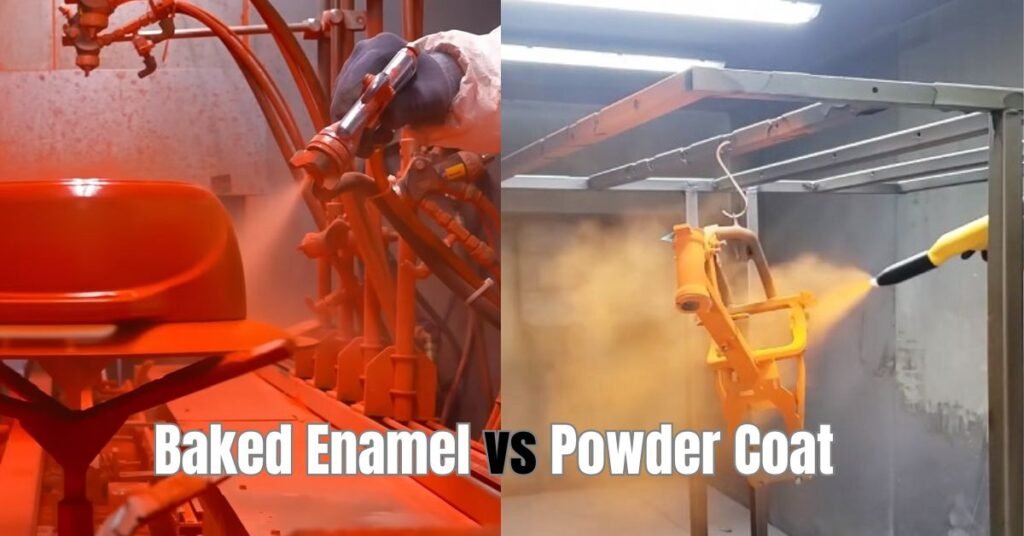Are you tired of choosing between durability and aesthetics when it comes to steel products? Well, we’ve got good news for you! Our guide on Powder Coated Steel vs Stainless Steel is here to unravel the mysteries and help you make an informed decision. Get ready to dive into the world of steel finishes and discover the perfect blend of style and strength.

Understanding Powder Coated Steel
Composition
Powder coated steel is made up of a base metal, typically steel, that has been coated with a layer of powder paint. The powder paint is made up of a mixture of finely ground particles of pigment and resin that are electrostatically charged and sprayed onto the metal surface. The charged particles adhere to the metal and create a smooth, durable finish.
Manufacturing Process
The manufacturing process for powder coated steel involves several steps. First, the metal is cleaned and prepared for coating by removing any rust, oil, or other contaminants. Next, the powder paint is applied using an electrostatic spray gun. The coated metal is then cured in an oven at high temperatures, which causes the powder paint to melt and fuse together, creating a hard, durable finish.
Advantages
Powder coated steel has several advantages over other types of finishes. It is highly durable and resistant to chipping, scratching, and fading, making it ideal for use in outdoor environments. It is also highly customizable, with a wide range of colors and finishes available. Additionally, powder coating is an environmentally friendly process, as it produces no VOCs or hazardous waste.
Disadvantages
Despite its many advantages, powder coated steel does have a few disadvantages. It can be more expensive than other types of finishes, particularly if custom colors or finishes are required. It is also more difficult to repair than other types of finishes, as the entire piece of metal may need to be recoated if damage occurs. Finally, powder coated steel is not as resistant to corrosion as stainless steel, so it may not be the best choice for use in harsh or corrosive environments.
Overall, powder coated steel is a highly durable and customizable finish that is ideal for use in outdoor environments. While it does have a few disadvantages, it is a popular choice for a wide range of applications and is widely available from many manufacturers.
Understanding Stainless Steel
Stainless steel is a type of steel that is widely used in various industries due to its corrosion-resistant properties. In this section, you will learn about the composition, manufacturing process, advantages, and disadvantages of stainless steel.
Composition
Stainless steel is an alloy composed of iron, carbon, and a minimum of 10.5% chromium by mass. Other elements such as nickel, molybdenum, and titanium may also be added to improve its properties. The addition of chromium creates a thin layer of oxide on the surface of the steel, which protects it from corrosion.
Manufacturing Process
Stainless steel is produced through a variety of manufacturing processes, including melting, casting, hot rolling, cold rolling, and annealing. The most common manufacturing process is melting, which involves melting the raw materials in a furnace and then casting them into ingots. The ingots are then rolled into sheets or other shapes.
Advantages
Stainless steel has several advantages over other materials. It is highly resistant to corrosion, which makes it ideal for use in harsh environments. It is also easy to clean and maintain, which makes it a popular choice for applications where hygiene is important. Stainless steel is also strong and durable, which makes it suitable for use in structural applications.
Disadvantages
Despite its many advantages, stainless steel also has some disadvantages. It is more expensive than other materials, which can make it cost-prohibitive for some applications. It is also heavier than other materials, which can make it difficult to handle and transport. Additionally, stainless steel is not as heat-resistant as other materials, which can limit its use in high-temperature applications.
In summary, stainless steel is a popular material due to its corrosion-resistant properties, ease of maintenance, and durability. However, it is more expensive and heavier than other materials and has limited use in high-temperature applications.
Comparative Analysis: Powder Coated Steel vs Stainless Steel
Durability
When it comes to durability, both powder coated steel and stainless steel have their advantages. Powder coated steel is highly resistant to scratches, chipping, fading, and corrosion, making it a great option for outdoor furniture, automotive parts, and appliances. However, if the powder coating is damaged, the underlying steel may be exposed to rust and other forms of corrosion.
On the other hand, stainless steel is known for its exceptional strength, toughness, and resistance to rust, stains, and heat. It is commonly used in industries such as construction, aerospace, and medical equipment. However, stainless steel can still be scratched or dented, and it may require occasional polishing to maintain its shine.
Cost
Powder coated steel is generally more affordable than stainless steel, making it a popular choice for budget-conscious consumers. The powder coating process is less expensive than the manufacturing and finishing processes required for stainless steel. Additionally, powder coated steel can be made from recycled materials, further reducing its cost.
Stainless steel is considered a premium material and is typically more expensive than powder coated steel. However, the cost of stainless steel can vary depending on the grade and finish. Higher-grade stainless steel with a polished finish will be more expensive than lower-grade stainless steel with a brushed finish.
Maintenance
Both powder coated steel and stainless steel require some level of maintenance to keep them looking their best. Powder coated steel should be cleaned regularly with a mild detergent and water to remove dirt and grime. Avoid using abrasive cleaners or tools that could scratch the surface.
Stainless steel should also be cleaned regularly to remove fingerprints, smudges, and other marks. A solution of water and vinegar can be used to clean and polish stainless steel. Avoid using harsh chemicals or abrasive sponges that could damage the surface.
Aesthetic Appeal
Powder coated steel and stainless steel have distinct aesthetic qualities that appeal to different tastes. Powder coated steel is available in a wide range of colors and finishes, making it a versatile option for designers and manufacturers. It can be made to look like wood, stone, or other materials, and it can be customized to match any color scheme.
Stainless steel has a sleek, modern look that is often associated with luxury and sophistication. It is commonly used in high-end appliances, kitchenware, and architectural features. Stainless steel can be polished to a mirror-like finish or left with a brushed finish for a more subtle look.
In summary, both powder coated steel and stainless steel have their advantages and disadvantages depending on your specific needs and preferences. Consider factors such as durability, cost, maintenance, and aesthetic appeal when choosing between the two materials.
Applications and Uses
Powder coated steel and stainless steel have different applications and uses, depending on the specific requirements of your project. Here are some common uses for each material:
Powder Coated Steel
Powder coated steel is a popular choice for outdoor applications such as:
- Fencing and gates
- Railings
- Outdoor furniture
- Automotive parts
- Appliances
Powder coating provides a durable, weather-resistant finish that can withstand exposure to the elements. It is also available in a wide range of colors, making it a versatile option for decorative applications.
Stainless Steel
Stainless steel is a corrosion-resistant material that is often used in applications that require high levels of hygiene and cleanliness, such as:
- Food processing equipment
- Medical equipment
- Pharmaceutical equipment
- Chemical processing equipment
- Marine applications
Stainless steel is also a popular choice for architectural applications such as:
- Balustrades
- Handrails
- Cladding
- Sculptures
Its sleek, modern appearance and durability make it a popular choice for high-end projects.
When deciding between powder coated steel and stainless steel, it’s important to consider the specific requirements of your project and choose the material that best meets those needs.
Finally, is Powder Coated or Stainless Steel Better?
Both powder coated steel and stainless steel have their own advantages and disadvantages. It ultimately depends on your specific needs and preferences when choosing between the two.
Powder coated steel is a more affordable option and offers a wide range of color options. It is also resistant to chipping, fading, and scratching. However, it may not be as durable as stainless steel and may require more maintenance over time.
On the other hand, stainless steel is a highly durable and corrosion-resistant material. It is also easy to clean and maintain. However, it is typically more expensive than powder coated steel and may not be available in as many color options. When deciding between powder coated steel and stainless steel, consider factors such as your budget, the intended use of the item, and the overall aesthetic you are trying to achieve. With this information in mind, you can make an informed decision that meets your needs and preferences.
How Long Does Powder Coated Steel Last?
Powder coated steel is known for its exceptional durability and longevity. When applied correctly, it can last up to 20 years or more, depending on various factors such as environmental conditions, maintenance, and usage. Regular cleaning and proper care can extend its lifespan even further.
Is Powder Coated Steel Durable?
Absolutely! Powder coated steel is renowned for its outstanding durability. The powder coating process creates a strong, protective layer that resists scratches, chipping, fading, and corrosion. This durability makes powder coated steel an excellent choice for various applications, from outdoor furniture to automotive parts.

